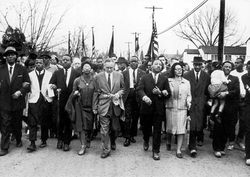Dr. King and SCLC leaders begin to march from Selma to Montgomery
This was the third attempt to conduct a nonviolent march in protest of the discrimination and intimidation the black population of Selma experienced during its attempt to register black voters. In January of 1965, Dr. Martin Luther King and the Southern Christian Leadership Conference (SCLC) announced a campaign to focus specifically on extending voting rights to the black population in Alabama. This campaign was of particular importance to the residents of Selma, as blacks accounted for more than 50% of its population, but, despite repeated efforts to register to vote, represented only 2% of registered voters at the time.
In February of 1965 during a nonviolent demonstration in Marion, Alabama, state troops joined local police forces to disband demonstrators and a state trooper fatally shot Jimmie Lee Jackson, a 26-year-old church deacon. In response to Jackson’s violent death and discrimination and intimidation of black voters throughout the state, activists set out on the first march from Selma to Montgomery on March 7. They were met with a blockade of state troopers and local law enforcement at Edmund Pettus Bridge, several miles outside of Selma. The confrontation turned violent as troopers attacked the marchers with clubs and tear gas. Many were severely injured as a result, and televised coverage of the incident caused national outrage, coining the event ‘Bloody Sunday.’
In response to this incident, Dr. King and leaders of the SCLC organized a second march from Selma to Montgomery on March 9, but were stopped once again at the Edmund Pettus Bridge, and, in light of the violence that occurred several days earlier, decided not to proceed. The first two attempts at this march brought national attention to the cause, including support from President Lyndon B. Johnson.
On March 16 Selma demonstrators submitted a marching plan to Judge Frank M. Johnson, Jr. The judge approved the plan and ordered Governor Wallace (an outspoken anti-integrationist) and local law enforcement not to harass, threaten marchers, or otherwise interfere with the March. Subsequently, President Johnson asked that Governor Wallace call to duty the 10,000 available National Guardsmen in Alabma to escort the marchers throughout the march and maintain a peaceful demonstration. Governor Wallace refused to do so. On March 20 President Johnson furiously contacted the National Guard in Alabama and coordinated necessary support for them to execute the mission.
The march lasted five days, as planned, from March 21-25. Some 50,000 marchers joined Dr. King on the road from Selma to Montgomery. The marchers camped overnight in yards of supporters, and were entertained along the way by notables such as Lena Horne and Harry Belafonte. The marchers arrived safely in Montgomery on March 25 and a delegation of leaders attempted to deliver a petition to Governor Wallace, but were unsuccessful.
Nonetheless, the march did achieve its ultimate goal in August of that year, when Congress passed the Voting Rights Act (79 to 18 in the Senate and 328 to 74 in the house), which President Johnson proudly signed into law on August 6, 1965. Among its provisions, the Act gave the executive branch of government direct authority to protect the voting rights of minorities and to keep watch on states that historically were known to discriminate against minority voters.
Forty-eight years later, on June 25, 2013 in the case of Shelby v. Holder the U.S. Supreme Court declared unconstitutional Section 4 of the Voting Rights Act, stating that ‘its formula can no longer be used as a basis for subjecting jurisdictions to preclearance.’ Section 4 primarily addresses the question of redistricting to enable some to vote while preventing others from doing the same. Shortly after the ruling, several states under Republican control passed legislation restricting voter eligibility. Many have commented on the implications of this ruling and its polarizing effect in today’s society. Since the ruling last June, Attorney General Eric Holder has decided to take a gamble and make voting rights a hallmark of his tenure by suing states who have passed such legislation in hope of bringing high profile cases to the Supreme Court once again to demonstrate the continued validity of Section 4 and repeal last year’s decision.
For more information on the march from Selma to Montgomery and the Voting Rights Act, please see below.
http://www.history.com/this-day-in-history/lbj-sends-federal-troops-to-alabama
http://www.nytimes.com/learning/general/onthisday/big/0321.html?action=click&module=Search®ion=searchResults%230&version=&url=http%3A%2F%2Fquery.nytimes.com%2Fsearch%2Fsitesearch%2F%3Faction%3Dclick%26region%3DMasthead%26pgtype%3DHomepage%26module%3DSearchSubmit%26contentCollection%3DHomepage%26t%3Dqry344%23%2Fmarch%2Bfrom%2BSelma%2Bto%2Bmontgormery%2F#article
http://www.americaslibrary.gov/jb/modern/jb_modern_selma_2.html
http://mlk-kpp01.stanford.edu/index.php/encyclopedia/encyclopedia/enc_selma_to_montgomery_march/
http://www.newyorker.com/arts/critics/atlarge/2013/07/08/130708crat_atlarge_menand?currentPage=5
http://www.newyorker.com/reporting/2014/02/17/140217fa_fact_toobin
http://www.scotusblog.com/2013/06/shelby-commentary-what-does-the-courts-decision-mean/

